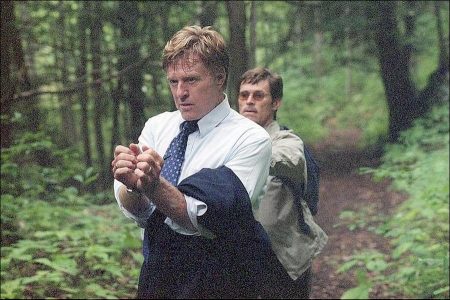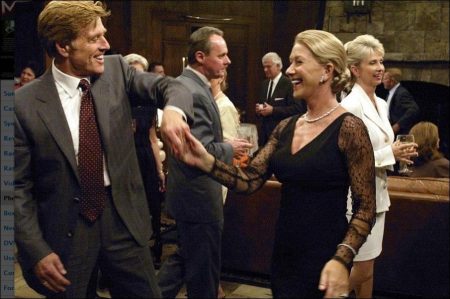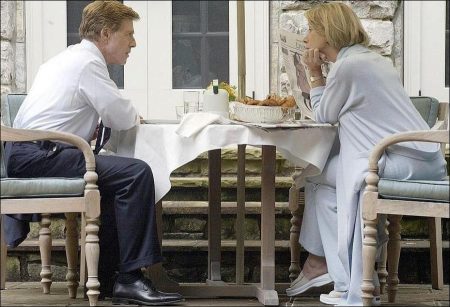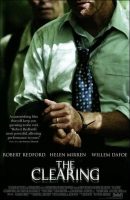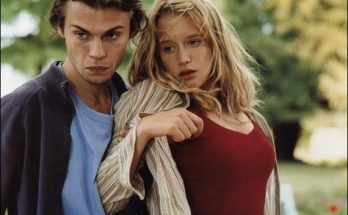Tagline: They’re going from players to playtime.
The Clearing movie storyline. Wayne and Eileen Hayes (Robert Redford, Helen Mirren) appear to be living the American dream. But all illusions are shattered when Wayne is kidnapped in broad daylight from the Hayes’ peaceful Pittsburgh estate.
Under the microscope of a probing FBI investigation and her own painstaking introspection, Wayne’s wife Eileen also becomes a victim. The interrogation introduces a life underneath outward appearances; the suspicions, the secrets, the inadequacies, and what can happen along the way to achieving the American dream.
Suddenly the man who, at one point in his life, prided himself on being a cunning negotiator finds his fate resting in the hands of a kidnapper (Willem Dafoe) who has nothing to lose and everything to gain. Will he succeed in the most important negotiation ever… for his life?
The Clearing is a 2004 American drama film and the directorial debut of Pieter Jan Brugge, who has worked as a film producer. The film is loosely based on the real-life kidnapping of Gerrit Jan Heijn that took place in the Netherlands in 1987. The screenplay was written by Justin Haythe.
Held Captive: The Genesis of The Clearing
The story of a parallel emotional struggle between the victim of a kidnapping and the family that is left behind had long occupied Director/Producer Pieter Jan Brugge’s thoughts. The native of Holland first conceived of the plotline as a result of an actual kidnapping in the Netherlands.
The details of the tragic event filled the Dutch media for more than 200 days and inspired Brugge to deeply ponder the effect the tragedy would have on all parties. After extensive research, Brugge felt the story would be a compelling basis for a film set in his country of residence.
“It was a story that allowed itself to be transposed to the American landscape,” says Brugge. “It provided the opportunity to say something about the American dream and the price people paid in its pursuit, as well as the price paid by those it has eluded.”
Brugge, who was nominated for an Oscar for producing The Insider, was also ready to make the transition to first-time director. “I’ve produced with some remarkable directors (Alan Pakula, Michael Mann, Warren Beatty) for many years, and since film school I’ve always had the dream and desire to direct,” he explains. “But I felt that I wanted to learn the craft of filmmaking first. The best way to learn the craft is as a producer because you can stand at the very genesis of an idea and you can see it all the way through the final release and watch the effect it has on an audience.”
To write the screenplay, Brugge hired Justin Haythe, who was at the time completing his first novel. After their initial meeting, Brugge was convinced that Haythe fully understood the director’s vision for the film. “I saw it as a thriller that is unflinching in its portraits of people and the mistakes they’ve made,” says Haythe. “In the pursuit of success there are winners and losers. But there is an enormous cost for both of them that is not simply material; it’s what we fritter away while chasing our goals and how we lose track of some of the people around us in achieving those goals. The idea of not being successful can seem so terrifying. But when you open that door and see what’s behind it, it’s often not a great deal.”
To create a compelling psychological thriller, Brugge conceived a structural approach that followed two tracks and showed two unique perspectives, while challenging the audience with its alteration of timelines. “You are first with Wayne and Eileen and when Eileen realizes her husband has disappeared, we then cut back to the day we first met them and see what has happened to build to this point.”
The parallel perspectives continue throughout the film showing the torment of Mr. and Mrs. Hayes. “One is the story of Eileen, whose life is turned inside out and upside down by the presence of the FBI in her home investigating Wayne’s abduction,” Brugge remarks. “The other story is the kidnapping itself, and what happens to Wayne Hayes after he has been abducted.
“The two stories reflect upon one another and resonate within each other,” he continues. “That resonance is really the story of the marriage of Wayne and Eileen and the love story between these two people.”
The filmmakers maintain the tension and shroud the mystery of Wayne’s fate until the final scenes of the film by altering the timescape of each parallel track. While Eileen’s story spans weeks, forcing her to initially dig deep inside herself for some clue and eventually sending her into a state of desperation, Wayne’s storyline lasts only one day but is equally as climactic. From breakfast to nightfall is the full extent of the most significant event of Wayne Hayes’ and his family’s life.
After three years of collaborating, Brugge and Haythe showed their script to producers Jonah Smith and Palmer West of Thousand Words who were immediately drawn to the unique concept of The Clearing. “I was surprised at how brave Justin was in his writing,” comments West. “It broke outside the conventional realm of storytelling and gave us something different.” Smith adds, “The script was unique and engaging, with complex characters… Pieter Jan had a distinct vision for the movie, which we believed in and wanted to develop.”
Smith and West also felt that even though Brugge was a first-time director, his considerable experience as a producer would be crucial in dealing with the potential obstacles of a difficult independent production. Thousand Words co-financed the project with Fox Searchlight Pictures.
The Clearing (2004)
Directed by: Pieter Jan Brugge
Starring: Robert Redford, Willem Dafoe, Helen Mirren, Alessandro Nivola, Melissa Sagemiller, Matt Craven, Wendy Crewson, Larry Pine, Diana Scarwid, Elizabeth Ruscio, Sarah Koskoff
Screenplay by: Justin Haythe
Production Design by: Lucrezia Casta, Chris Gorak
Cinematography by: Denis Lenoir
Film Editing by: Kevin Tent
Costume Design by: Florence-Isabelle Megginson
Set Decoration by: Marthe Pineau
Art Direction by: Paul Huggins
Music by: Craig Armstrong
MPAA Rating: R for brief strong language.
Studio: Fox Searchlight Pictures
Release Date: July 2, 2004
Views: 68
